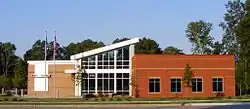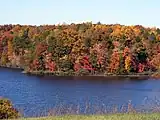Butner, North Carolina
Butner is a town in Granville County, North Carolina, United States. The population was 8,397 as of the 2020 census.[4] Butner was managed by the state of North Carolina from 1947 through 2007.
Butner, North Carolina, | |
|---|---|
 Butner Town Hall | |
 Seal | |
 Location of Butner, North Carolina | |
| Coordinates: 36°07′43″N 78°45′00″W | |
| Country | United States |
| State | North Carolina |
| County | Granville |
| Area | |
| • Total | 14.05 sq mi (36.39 km2) |
| • Land | 14.03 sq mi (36.33 km2) |
| • Water | 0.03 sq mi (0.06 km2) |
| Elevation | 361 ft (110 m) |
| Population (2020) | |
| • Total | 8,397 |
| • Density | 598.67/sq mi (231.15/km2) |
| Time zone | UTC-5 (Eastern (EST)) |
| • Summer (DST) | UTC-4 (EDT) |
| ZIP code | 27509 |
| Area code | 919 |
| FIPS code | 37-09360[3] |
| GNIS feature ID | 2424932[2] |
| Website | butnernc |

History
A bill passed by the North Carolina General Assembly incorporating the town was signed by Gov. Mike Easley on July 27, 2007.[5]
It is the former site of the U.S. Army's Camp Butner, which was named for Major General Henry W. Butner (1875–1937), a North Carolina native.[6][7] The area around Butner has several state and federal correctional institutions.
Geography
 Gazebo Park
Gazebo Park Lake Holt
Lake Holt
Butner is located in southwestern Granville County. Interstate 85 passes through the town, southeast of the town center, with access from Exits 186, 189, and 191. I-85 leads northeast 16 miles (26 km) to Oxford, the Granville County seat, and southwest 13 miles (21 km) to Durham. Butner is bordered to the east by the city of Creedmoor.
According to the United States Census Bureau, the town has a total area of 13.9 square miles (36.1 km2), of which 0.02 square miles (0.06 km2), or 0.18%, is water.[8]
Demographics
| Census | Pop. | Note | %± |
|---|---|---|---|
| 1970 | 3,538 | — | |
| 1980 | 4,240 | 19.8% | |
| 1990 | 4,679 | 10.4% | |
| 2000 | 5,792 | 23.8% | |
| 2010 | 7,591 | 31.1% | |
| 2020 | 8,397 | 10.6% | |
| 2022 (est.) | 8,566 | [9] | 2.0% |
| U.S. Decennial Census[10] | |||
2020 census
| Race | Number | Percentage |
|---|---|---|
| White (non-Hispanic) | 3,421 | 40.74% |
| Black or African American (non-Hispanic) | 2,663 | 31.71% |
| Native American | 27 | 0.32% |
| Asian | 46 | 0.55% |
| Pacific Islander | 2 | 0.02% |
| Other/Mixed | 324 | 3.86% |
| Hispanic or Latino | 1,914 | 22.79% |
As of the 2020 United States census, there were 8,397 people, 2,865 households, and 2,022 families residing in the town.
2010 census
As of the census of 2010, there were 7,591 people in 2,767 households. The population density was 1,150.2 inhabitants per square mile (444.1/km2). There were 2,999 housing units at an average density of 454.4 per square mile (175.4/km2). The racial makeup of the town was 59.5% White, 30.1% African American, 0.7% Native American, 0.8% Asian, 6.5% from other races, and 2.3% from two or more races. Hispanic or Latino of any race were 14.7% of the population.
There were 2,767 households, out of which 33.0% had children under the age of 18 living with them. The average household size was 2.74. In the town, the population was spread out, with 26.0% under the age of 18, 7.6% from 18 to 24, 13.8% from 25 to 34, 23.3% from 35-49, 18.8% from 50 to 64, and 10.4% who were 65 years of age or older. For every 100 females, there were 97.3 males.
The median income[12] for a household in the town was $45,437, and the mean income for a household was $51,466. The median and mean incomes for families were $53,186 and $55,847, respectively. The per capita income for the town was $17,654. About 4.1% of families and 13.5% of the population were below the poverty line, including 9.2% of those under age 18 and 12.8% of those age 65 or over.
Infrastructure
The area surrounding Butner includes:
- Camp Butner Training Center (Run by the North Carolina National Guard, consisting of roughly 5,000 acres)
- Federal Correctional Complex, Butner (4 units and one medical center, consisting of Camp Butner for males only, FCI Butner Low, FCI Butner Medium I, FCI Butner Medium II, and Federal Medical Center)
- Polk Correctional Institution, a facility of the North Carolina Department of Correction
- C.A. Dillon Youth Development Center, a juvenile facility of the North Carolina Department of Public Safety (formerly the North Carolina Department of Juvenile Justice and Delinquency Prevention)[13]
- Several facilities of the North Carolina Department of Health and Human Services (Murdoch Developmental Center, Whitaker School, R. J. Blackley Alcohol and Drug Abuse Treatment Center, and Central Regional Hospital replacing John Umstead Hospital in Butner as well as Dorothea Dix Hospital in Raleigh).
References
- "ArcGIS REST Services Directory". United States Census Bureau. Retrieved September 20, 2022.
- U.S. Geological Survey Geographic Names Information System: Butner, North Carolina
- "U.S. Census website". United States Census Bureau. Retrieved January 31, 2008.
- "Explore Census Data". data.census.gov. Retrieved December 6, 2021.
- NC General Assembly
- "History from NC Dept. of Public Instruction site". Archived from the original on February 2, 2007. Retrieved February 6, 2007.
- "Camp Butner –On Duty for the Nation, 1942-1947". Archived from the original on December 1, 2007. Retrieved October 11, 2007.
- "Geographic Identifiers: 2010 Demographic Profile Data (G001): Butner town, North Carolina". American Factfinder. U.S. Census Bureau. Retrieved January 6, 2017.
- "Population and Housing Unit Estimates". United States Census Bureau. May 24, 2020. Retrieved May 27, 2020.
- "Census of Population and Housing". Census.gov. Retrieved June 4, 2015.
- "Explore Census Data". data.census.gov. Retrieved December 23, 2021.
- Fact Finder, United States Census Bureau Archived February 10, 2020, at archive.today, Retrieved November 11, 2011
- "Youth Development Centers Archived December 22, 2015, at the Wayback Machine." North Carolina Department of Public Safety. Retrieved on December 16, 2015. "C. A. Dillon Youth Development Center 100 Dillon Drive Butner, N.C. 27509"

